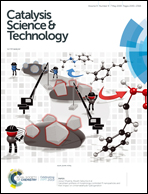General scaling relations and prediction of transition state energies in CHA/AlPO-34-structured zeolite catalysis related to the methanol-to-olefins conversion†
Abstract
Linear energy scaling relations constitute the basis of computational design of catalysts using a descriptor-based approach. Herein, we demonstrated the general applicability of the scaling relations in Brønsted acid zeolite catalysis with acid strength. Using ammonia adsorption enthalpy as the descriptor of acid strength, the scaling relations of transition state (TS) energies were established in CHA/AlPO-34-structured zeolites or zeotypes among a series of elementary reactions with relevance to methanol-to-olefins conversion, for example, methylation, ethylation, hydride transfer, cyclization, and cracking. The scaling slope, e.g. the sensitivity of TS enthalpy versus acid strength, was revealed to approximately linearly correlate with the charge variation of the framework in the reaction. These findings enable fast and accurate prediction of the TS energies of systems with different acid strengths or compositions in one given framework topology, similar to those in metal or oxide catalysis in which the scaling relations are established with composition in one specific surface, and therefore open up an avenue for the rational design of zeolite catalysts for complex industrially relevant reactions.



 Please wait while we load your content...
Please wait while we load your content...